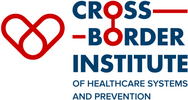
CHARE-GD II Subproject 4: Multidrug-Resistant Bacteria (MDR) - Analysis of Differences in Infection Prevention and Control Measures, Diagnostic Workup and MDR Prevalence in the Ems-Dollart Region
CHARE-GD II Subproject 4: Multidrug-Resistant Bacteria (MDR) - Analysis of Differences in Infection Prevention and Control Measures, Diagnostic Workup and MDR Prevalence in the Ems-Dollart Region
PIs: Prof. Dr. Axel Hamprecht, Dr. Corinna Glasner
For other languages, see Nederlands and Deutsch.

About the project
Antimicrobialresistance (AMR) is considered among the top 10 threats to global health. Without further action, AMR could cause 39.1 million direct deaths and 169 million associated deaths by 2050.
“Global Action Plan on AMR” by the World Health Organisation urges international action and cross-border collaboration to address AMR spread.
Vancomycin-resistant enterococci (VRE) in hospital settings across European borders: a scoping review comparing the epidemiology in the Netherlands and Germany.
Purpose of the article
Enterococci, nosocomial pathogens that are common worldwide, are a cause for particular concern in European hospitals due to the increase in vancomycin-resistant enterococci (VRE). The prevalence of VRE varies between the Netherlands and Germany, but has not yet been analysed in a comprehensive nationwide study. The aim is to conduct a comprehensive analysis of VRE epidemiology in German and Dutch hospitals, focusing on outbreaks, colonisation prevalence and the proportion of clinical isolates. The study is based on the literature and on national and European surveillance data.
Key findings
The study reveals different patterns in VRE prevalence between Germany and the Netherlands. While an upward trend in VRE prevalence can be observed in Germany, the situation in the Netherlands remains more stable. Factors such as differences in healthcare systems, infection control guidelines, varying antibiotic consumption and differences in diagnostics contribute to these contrasting trends. In particular, the effects of the COVID-19 pandemic and a change in the molecular epidemiology of VRE over time are observed commonalities.
Implications
Given the continuing rise of VRE in Europe, the study highlights the urgency of addressing this challenge in healthcare. The findings underscore the need for tailored strategies in each country, taking into account healthcare system structures, infection control measures and antibiotic use practices. The study calls for further research to unravel the complex factors influencing VRE prevalence, paving the way for effective control and prevention strategies. Understanding these dynamics is critical to mitigating the impact of VRE on patient outcomes, healthcare costs and antibiotic resistance on a global scale.
Would you like to know more?
You can find this study here: https://aricjournal.biomedcentral.com/articles/10.1186/s13756-023-01278-0
Cimen, C., Berends, M. S., Bathoorn, E., Lokate, M., Voss, A., Friedrich, A. W., Glasner, C., & Hamprecht, A. (2023). Vancomycin-resistant enterococci (VRE) in hospital settings across European borders: a scoping review comparing the epidemiology in the Netherlands and Germany. Antimicrobial Resistance & Infection Control, 12(1), 78.
Surface water in Lower Saxony: A reservoir for multidrug-resistant Enterobacterales.
Purpose of the article
The study aims to investigate the prevalence of multidrug-resistant (MDR) Enterobacterales, particularly extended-spectrum β-lactamase- and carbapenemase-producing strains, in surface waters in Lower Saxony, Germany. The research focuses on rivers, water channels near agricultural operations, and recreational lakes, examining the diversity of antibiotic resistance genes in these environments.
Key Findings
The research identifies MDR Enterobacterales in 16% of the sampled waters, including rivers, water channels, and recreational lakes. Nine out of 31 water samples (29%) contained MDR Enterobacterales, including 21 different isolates. The study reveals the presence of various carbapenemase genes, including blaKPC-2, blaVIM-1, and blaOXA-181, with blaKPC-2 being the most frequently detected. Notably, a unique combination of blaKPC-2, blaVIM-1, and the mobile colistin resistance gene mcr-9 was detected in Citrobacter freundii. Resistance to last-resort antibiotics, cefiderocol and colistin, was observed, highlighting the severity of antibiotic resistance in environmental strains.
Implications
The study highlights the high prevalence of antibiotic-resistant Enterobacterales in surface waters in Lower Saxony. Resistance to cefiderocol and colistin—important antibiotics for combating resistant bacteria—emphasizes the urgency of addressing antibiotic resistance in the environment. The findings support the need for continuous monitoring and control of environmental sources and underscore the connection between human, animal, and environmental health in combating the global threat of antibiotic resistance. Further research is crucial to fully understand the extent of antibiotic resistance and its impact on public health.
Would you like to know more?
You can find this study here: https://www.ncbi.nlm.nih.gov/pmc/articles/PMC10424258/pdf/main.pdf
Cimen C, Noster J, Stelzer Y, Rump A, Sattler J, Berends M, Voss A, Hamprecht A. Surface water in Lower Saxony: A reservoir for multidrug-resistant Enterobacterales. One Health. 2023;17:100606. DOI: 10.1016/j.onehlt.2023.100606
Uncovering the spread of drug-resistant bacteria through next-generation sequencing based surveillance: transmission of extended-spectrum β-lactamase-producing Enterobacterales by a contaminated duodenoscope.
Purpose of the article
Contamination of duodenoscopes is a significant concern due to the transmission of multidrug-resistant organisms (MDROs) among patients who undergo endoscopic retrograde cholangiopancreatography (ERCP), resulting in outbreaks worldwide. The aim of the study was to demonstrate the effectiveness of routine-based Next-generation sequencing (NGS) in uncovering the source of an outbreak, by detection a contaminated ERCP duodenoscope as the origin of Extended-spectrum β-lactamase (ESBL)-producing Citrobacter freundii and Klebsiella pneumoniae in patients.
Key findings
With the outbreak investigation we conducted, three probable cases and three proven cases who were colonised or infected by ESBL-producing Citrobacter freundii and Klebsiella pneumoniae were identified.Despite intensive consecutive cultures of the duodenoscope failing to detect any microorganisms, guiding NGS analysis and dismantling of the duodenoscope revealed that ESBL-producing K. pneumoniae was transmitted by the suspected duodenoscope.
Implications
Our study underscores the role of routine NGS-based surveillance and accompanying extensive epidemiological investigation in the detection and management of MDRO outbreaks. The results of this study call for a review of existing protocols and a consensus on improved sampling methods to enhance the detection and prevention of duodenoscope associated infections, while also emphasizing the necessity for future research to systematically assess the cost-effectiveness of routine NGS typing.
Would you like to know more?
You can find this study here: https://aricjournal.biomedcentral.com/articles/10.1186/s13756-024-01386-5
Cimen C, Bathoorn E, Loeve AJ, Fliss M, Berends MS, Nagengast WB, Hamprecht A, Voss A, Lokate M. Uncovering the spread of drug-resistant bacteria through next-generation sequencing based surveillance: transmission of extended-spectrum β-lactamase-producing Enterobacterales by a contaminated duodenoscope. Antimicrob Resist Infect Control. 2024 Mar 8;13(1):31. doi: 10.1186/s13756-024-01386-5
Infection prevention and control without borders: comparison of guidelines on multidrug-resistant organisms in the northern Dutch-German cross-border region
Purpose of the study
Multidrug-resistant organisms (MDROs) are a growing threat to patient safety and healthcare systems, due to their association with increased morbidity, mortality, and healthcare costs. To reduce their spread, robust infection prevention and control (IPC) measures are essential. While international and national IPC guidelines exist, their lack of harmonization complicates care for patients who move across borders. This study explored similarities and differences in IPC guidelines for vancomycin-resistant enterococci (VRE) and multidrug-resistant (MDR) Enterobacterales at both national and local levels within the northern Dutch-German cross-border region.
Key findings
The study found that although IPC efforts in both countries are rooted in national guidance, local adaptations vary significantly. In Germany, IPC is typically led by hospital hygiene doctors, while in the Netherlands, it involves a multidisciplinary collaboration between infection preventionists and clinical microbiologists. Dutch guidelines for VRE are notably more stringent, often introducing additional local measures beyond the national standard. Definitions of MDR Gram-negative bacteria differ as well: German guidelines do not recommend screening or isolation for extended-spectrum beta-lactamase-producing Enterobacterales (ESBL-E), whereas Dutch guidelines do. For carbapenem-resistant and carbapenemase-producing Enterobacterales (CRE/CPE), both countries apply similar measures, aiming to maintain low prevalence and prevent further spread.
Implications
The differences between Dutch and German IPC guidelines can create challenges in cross-border healthcare, particularly during patient transfers, leading to communication gaps and inconsistent hygiene practices. These differences likely reflect not only varying national priorities and structures but also evolving scientific understanding and ongoing debates around MDRO transmission and control strategies. The study highlights the need for greater cross-border collaboration on IPC guidelines, strengthen regional MDRO containment, and ultimately improve patient care across healthcare systems that frequently interact.
Would you like to know more?
Antimicrob Resist Infect Control. 2025 Feb 12;14(1):11. doi: 10.1186/s13756-025-01528-3.
Temporal trends of enterococcal and vancomycin-resistant Enterococcus faecium bacteraemia in the northern Dutch-German cross-border region: A 10-y multicentre analysis (2013-2022)
Purpose of the study
This study aimed to analyse trends in the occurrence of enterococcal and vancomycin-resistant Enterococcus faecium(VREfm) bacteraemia over a ten-year period in two university hospitals located in the northern Dutch-German cross-border region: the University Medical Centre Groningen (UMCG) in the Netherlands and the Klinikum Oldenburg (KOL) in Germany. The goal was to identify patterns and differences in enterococcal bacteraemia occurrence between the two institutions to better understand regional epidemiology.
Key findings
Between 2013 and 2022, 738 episodes of enterococcal bacteraemia were recorded at KOL and 1091 at UMCG. E. faeciumwas the most common species in both hospitals. Patients at KOL tended to be older than those at UMCG. The majority of infections occurred in intensive care and haematology/oncology wards. From 2018 to 2022, UMCG had higher overall incidence rates of E. faecium and E. faecalis bacteraemia. However, VREfm incidence was significantly higher at KOL (0.56 vs. 0.05 per 10,000 patient-days, p<.0001). At KOL, a significant increase in both the number of VREfm cases (p= .01) and the proportion of VREfm among E. faecium bacteraemia (p= .027) was observed over time, while UMCG did not show such a trend.
Implications
The findings indicate a stark contrast in VREfm bacteraemia trends between the Dutch and German hospitals, reflecting broader national patterns but also highlighting local variation. The differences highlight the importance of cross-border cooperation in antimicrobial resistance monitoring and management, particularly in shared regions where patient mobility is common. Given the increasing prevalence of VRE in Europe, further research and continuous analysis are needed to track local epidemiology in regional healthcare networks and to inform clinical decision-making in the cross-border regions.
Would you like to know more?
You can find this study here: https://www.sciencedirect.com/science/article/pii/S2213716525000578?via%3Dihub
J Glob Antimicrob Resist. 2025 May;42:187-194. doi: 10.1016/j.jgar.2025.02.022. Epub 2025 Mar 5.

